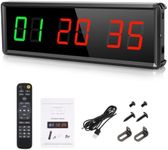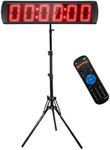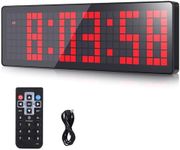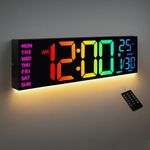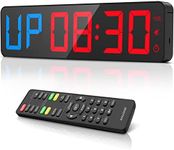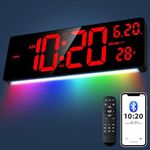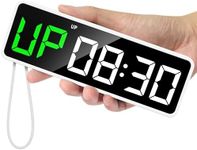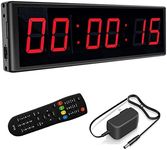Buying Guide for the Best Gym Clocks
Choosing the right gym clock can significantly enhance your workout experience by helping you keep track of time, manage intervals, and stay on schedule. When selecting a gym clock, it's important to consider various specifications to ensure it meets your needs and preferences. Here are some key specs to consider and how to navigate them to find the best fit for you.Display TypeThe display type of a gym clock refers to how the time and other information are shown. This can be in the form of LED, LCD, or analog displays. LED displays are bright and easy to read from a distance, making them ideal for large gym spaces. LCD displays are more energy-efficient and can be easier on the eyes in low-light conditions. Analog displays, while less common, offer a classic look and can be suitable for smaller, more personal gym settings. Choose a display type that matches the lighting and size of your workout area.
SizeThe size of the gym clock is important for visibility and placement. Larger clocks are easier to see from a distance, which is beneficial in bigger gyms or for group workouts. Smaller clocks can be more discreet and are suitable for home gyms or personal training spaces. Consider the size of your workout area and how far you will be from the clock during your exercises to determine the appropriate size.
Timer FunctionsTimer functions include features like countdown timers, interval timers, and stopwatch capabilities. These functions are crucial for managing different types of workouts, such as HIIT, circuit training, or timed sets. Basic models may only offer a simple countdown timer, while more advanced models can have programmable intervals and multiple timer settings. Think about the types of workouts you do and choose a clock with the timer functions that will best support your training regimen.
Sound AlertsSound alerts help you stay on track by providing audible cues for start and stop times, intervals, and other important moments during your workout. Some clocks offer adjustable volume levels or different types of sounds to suit your preferences. If you work out in a noisy environment or need clear signals to change exercises, look for a clock with strong and customizable sound alerts. If you prefer a quieter workout, consider a clock with softer or optional sound alerts.
Power SourceGym clocks can be powered by batteries, electricity, or a combination of both. Battery-powered clocks offer portability and can be placed anywhere without the need for a power outlet, but they require regular battery changes. Electric clocks provide a constant power source and are ideal for permanent installations, but they need to be near an outlet. Some models offer both options for added flexibility. Consider where you plan to place the clock and whether you prefer the convenience of battery power or the reliability of an electric connection.
DurabilityDurability is important, especially in a gym environment where equipment can be subject to heavy use and occasional impacts. Look for clocks made from sturdy materials that can withstand the rigors of a gym setting. Water resistance can also be a valuable feature if the clock will be exposed to sweat or humidity. Assess the conditions in your gym and choose a clock that is built to last in that environment.
Mounting OptionsMounting options refer to how the clock can be installed or placed in your gym. Wall-mounted clocks save floor space and are easily visible, while freestanding models offer flexibility in placement. Some clocks come with brackets or stands for versatile mounting options. Consider the layout of your gym and where you want the clock to be positioned to determine the best mounting option for your needs.
